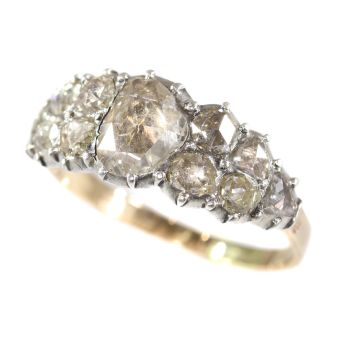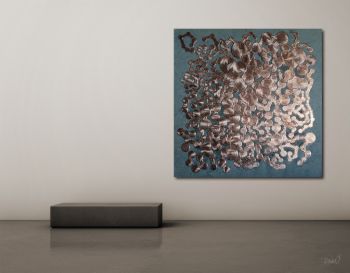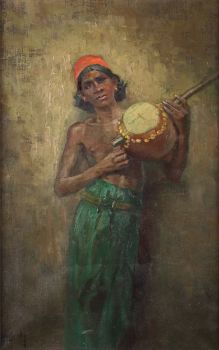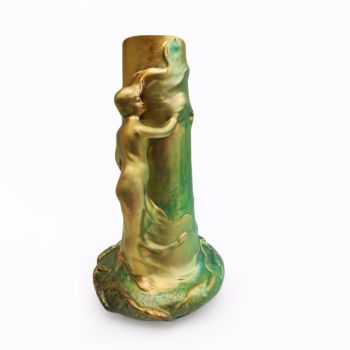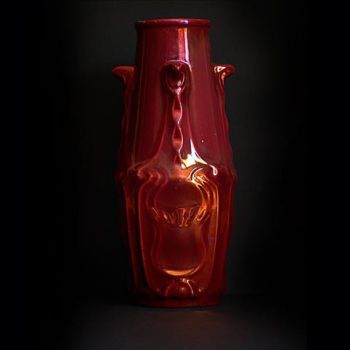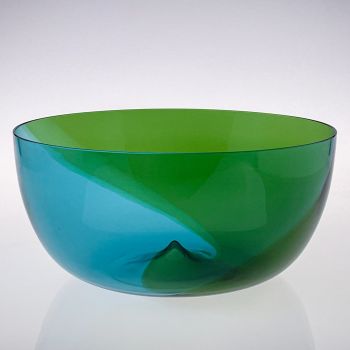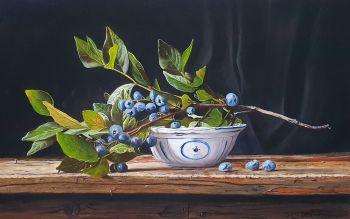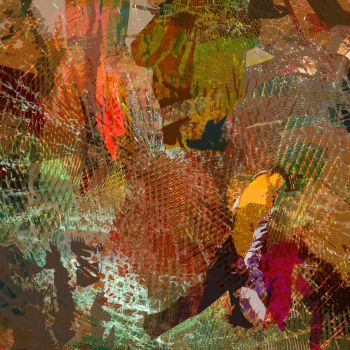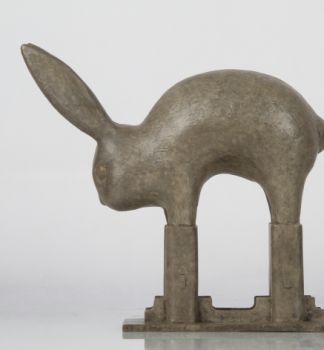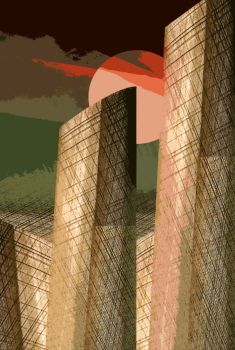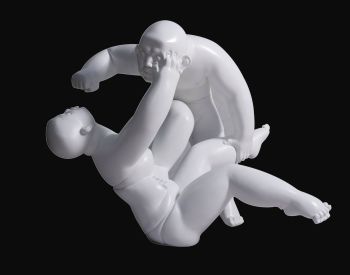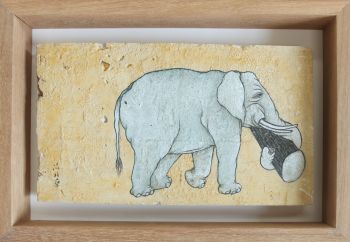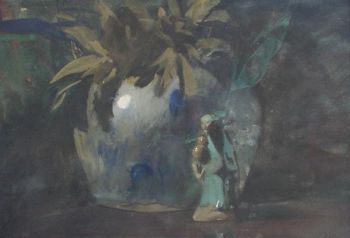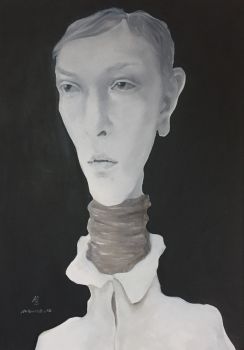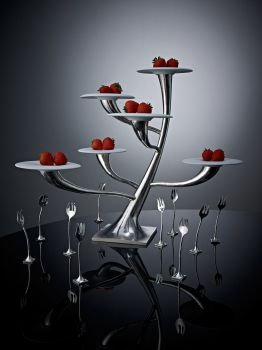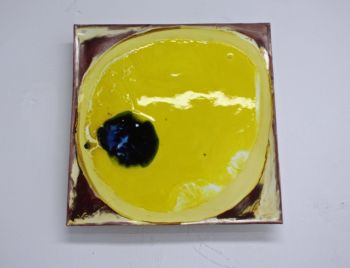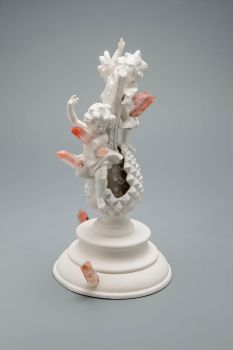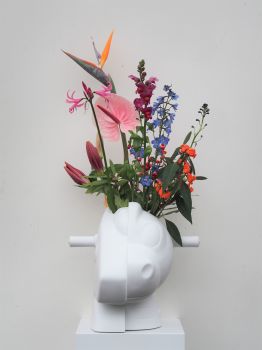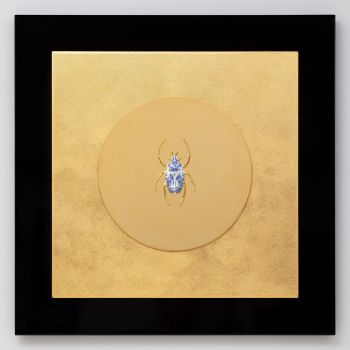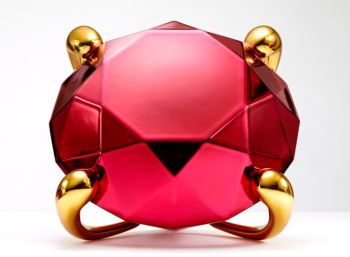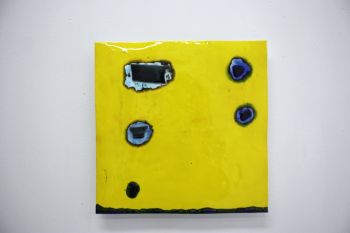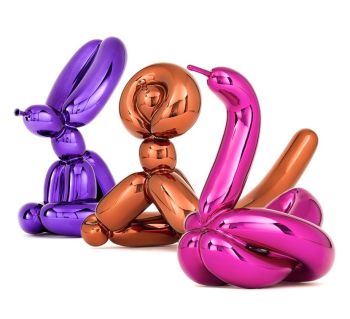A Chinese porcelain blue and white 'Mantou Xin' bowl, Kangxi period (1661-1722) 1700 - 1720
Artista Sconosciuto
Porcellana
7.10 cm, ø 19.20 cm
ConditionGood
Prezzo su richiesta
Menken Works of Art
- A proposito di opere d'arteA blue and white bowl with various Taoist symbolic decorations.
Kangxi period (1661-1722), ca. 1700-1720, China.
The low bowl with interesting convex centre and flared wall.
Inside showing four figures representing Lan Caihe holding a ruyi and a flower basket, slung on a hoe (ancient farming tool) over the shoulder. The convex centre surrounded by a band showing the Eight Treasures (pearl, rhinoceros horn, shell, fishes, never-ending knot, books and a coral stick).
The outside with a band of Wan or Swastika’s in relief with the recess background cleverly showing the biscuit of the porcelain. Underneath the upper swastika band showing the Flowers of the Four Seasons. Underneath the flowers a band of ruyi heads, the bowl resting on a high footring with concave centre.
About Lan Caihe:
Lan Caihe is one of the eight Taoist immortals and the patron saint of florists and gardeners. Sometimes portrayed as a woman, other times as a hermaphrodite, Caihe is a symbol of elusive pleasure and represents innocence and happiness. It is said Lan Caihe wandered the streets as a beggar in worn clothing and with one foot bare, denouncing the elusive pleasures of this fleeting life.
About the Eight Treasures:
Also known as ba bao, this early motif of eight symbols was not merely a decorative pattern that occurred on Chinese works of art, but originally had a symbolic importance reflecting aspirations for status, wealth, and position as well as philosophic allegiance.
About the Flowers of the Four Seasons:
This representation is frequently seen in paintings or depictions on porcelain. A flower or plant representing each of the seasons: plum blossom for winter, grass orchid for spring, lotus for summer and chrysantemum for autumn.
About the Wan or Swastika symbol:
The Wan has been used as a design motif in every imaginable medium. In spite of contrasting views on its origin, it is historically tied to Buddhism and in Chinese folklore it symbolised good luck and eternal abundance. The term Swastika is derived from the Sanskrit su “well” and as “to be”, meaning “so be it” and denoting resignation of the spirit. It is styled the “ten thousand character sign” (wànzì) and is said to have come from heaven. It is described as “the accumulation of lucky signs possessing ten thousand efficacies”. It is also regarded as the symbol or seal of Buddha’s heart and is usually placed on the heart of Shâkyamuni Buddha.
Provenance:
From a private Dutch noble collection.
Identical bowls can be found in several museum collections:
Victoria & Albert Museum London (accession number C.941-1910)
The Frick Collection, New York (accession number 1965.8.75)
Rijksmuseum Amsterdam (object number AK-NM-6845)
Groninger Museum (object number 1899.0360)
Museum Arnhem (inv. nr. GM10.412).
Lit:
Hartog, Stephen - Pronken met Oosters Porselein, p. 67 / nr. 49.
Dimensions:
Diameter 19.2 cm, height 7.1 cm.
Condition (DM for more condition pictures):
Four chips on the mouth rim, furthermore in perfect condition.
Inv. No: A00389 - A proposito di opere artista
Può succedere che un artista o un creatore sia sconosciuto.
Alcune opere non sono determinate da chi sono state realizzate o sono state realizzate da (un gruppo di) artigiani. Esempi sono statue dell'antichità, mobili, specchi o firme non chiare o leggibili ma anche alcune opere non sono affatto firmate.
Inoltre puoi trovare la seguente descrizione:
•"Attribuito a …." A loro avviso probabilmente opera dell'artista, almeno in parte
•“Studio di ….” o “Officina di” A loro avviso un'opera eseguita nello studio o nella bottega dell'artista, eventualmente sotto la sua supervisione
•“Cerchio di…” A loro avviso un'opera del periodo dell'artista che mostra la sua influenza, strettamente legata all'artista ma non necessariamente al suo allievo
•"Stile di..." o "Seguace di..." A loro avviso un'opera eseguita nello stile dell'artista ma non necessariamente da un allievo; può essere contemporaneo o quasi contemporaneo
•“Modalità di…” A loro avviso un'opera nello stile dell'artista ma di epoca successiva
•"Dopo …." A loro avviso una copia (di qualsiasi data) di un'opera dell'artista
•“Firmato…”, “Datato…” o “Iscritto” A loro avviso l'opera è stata firmata/datata/inscritta dall'artista. L'aggiunta di un punto interrogativo indica un elemento di dubbio
•"Con firma....", "Con data...", "Con iscrizione..." o “Riporta firma/data/iscrizione” a loro avviso la firma/data/iscrizione è stata aggiunta da qualcuno diverso dall'artista
Sei interessato ad acquistare questa opera d'arte?
Artwork details
Related artworks
- 1 - 4 / 12
Artista Sconosciuto
A blue and white Romance of the Three Kingdoms charger, Kangxi period (1661-1722)1661 - 1722
Prezzo su richiestaMenken Works of Art
Artista Sconosciuto
Chinese carnelian agate vase or brush washer, 18th/19th century, Qing dynasty1720 - 1820
Prezzo su richiestaMenken Works of Art
HUGO VILFRED VON PEDERSEN
Gadesanger fra Singapore (Musician from Singapore)1870 - 1959
Prezzo su richiestaZebregs & Röell - Fine Art - Antiques
1 - 4 / 10Artista Sconosciuto
A blue and white Romance of the Three Kingdoms charger, Kangxi period (1661-1722)1661 - 1722
Prezzo su richiestaMenken Works of Art
Artista Sconosciuto
Un gobelet anglais-néerlandais1738
Prezzo su richiestaPeter Korf de Gidts - Antiquairs
1 - 4 / 24Artista Sconosciuto
A blue and white Romance of the Three Kingdoms charger, Kangxi period (1661-1722)1661 - 1722
Prezzo su richiestaMenken Works of Art
Jan Voerman sr
Still Life with flowers in a Chinese figurine1850 - 1900
Prezzo su richiestaKunsthandel Pygmalion
1 - 4 / 24Artista Sconosciuto
Series of 6 Chinese cups and saucers (Yongzheng period)1722 - 1735
Prezzo su richiestaKuipers Kunst & Antiek
Samuel Dejong
Anatomia Blue heritage II Goliath Beetle closed BGG2019
Prezzo su richiestaVilla del Arte Galleries
Artista Sconosciuto
A large Japanese Imari porcelain 'VOC Groningen' dish1800 - 1925
Prezzo su richiestaZebregs & Röell - Fine Art - Antiques
1 - 4 / 24Artista Sconosciuto
A blue and white Romance of the Three Kingdoms charger, Kangxi period (1661-1722)1661 - 1722
Prezzo su richiestaMenken Works of Art
Artista Sconosciuto
Two large Chinese carved wooden architectural wall panels, Qing dynasty, 19th century19th century
Prezzo su richiestaMenken Works of Art
Artista Sconosciuto
Chinese gilt bronze censer, Xuande mark, 18th century, Qing dynasty18th century
Prezzo su richiestaMenken Works of Art
Artista Sconosciuto
Chinese carnelian agate vase or brush washer, 18th/19th century, Qing dynasty1720 - 1820
Prezzo su richiestaMenken Works of Art
1 - 4 / 6




